DMEK offers an additional corneal transplantation option
Click Here to Manage Email Alerts
 Thomas John |
Corneal transplantation has continued to evolve from an already excellent procedure such as Descemet’s stripping automated endothelial keratoplasty to what many surgeons believe to be a superior procedure: Descemet’s membrane endothelial keratoplasty, or DMEK.
Corneal surgeons have recently learned and nearly perfected their skill set for performing DSAEK and providing a good visual outcome by embracing this new selective corneal transplantation procedure. The advantage of DSAEK is that the donor Descemet’s membrane is supported by a posterior stromal disc, which provides some rigidity and makes surgical handling reasonably comfortable for the experienced DSAEK surgeon. Additionally, in DSAEK, a decentered donor disc in the case of air-assisted attachment to the recipient cornea can be easily corrected by direct mechanical shifting using a reverse Sinskey hook. However, this surgical technique also yields increased final corneal thickness and an intrastromal (stroma-to-stroma) interface.
In DMEK, the stroma is removed from the donor disc, so the donor disc rigidity that was surgeon-friendly in DSAEK is no longer present in DMEK. Instead, the pure Descemet’s membrane with the healthy endothelial cells scrolls on itself, with the endothelial cells on the outside. This introduces a surgical paradigm shift from DSAEK to DMEK, and those surgeons who wish to pursue DMEK have to go back to the drawing board and learn an almost completely new surgical technique that requires a new skill set to successfully perform reproducibly.
Each surgeon needs to consider whether he wants to make this surgical jump from DSAEK to DMEK. With DSAEK we have happy patients; will they be happier with DMEK, and is the surgeon prepared to pay the price?
In this column, I offer pearls for performing DMEK using four cases to illustrate. My preferred anesthesia is monitored anesthesia care with topical 2% lidocaine jelly. However, general anesthesia may be used, especially in the early phase of the learning curve.
DMEK pearls
1. Make a circular mark of the desired diameter, usually 8 mm (Figure 1) or 9 mm, on the recipient corneal epithelial surface. This will serve as a guide to assist in the descemetorrhexis. A John Dexatome spatula (ASICO) is used to perform the scoring of the recipient Descemet’s membrane in the anterior chamber filled with Healon (sodium hyaluronate, Abbott Medical Optics) and removal of the Descemet’s membrane as a single disc. The special design of this spatula allows for easy access to all points within the inner surface of the patient’s cornea.
2. The John Dexatome spatula is used first to release the peripheral margins of the Descemet’s membrane in a circular manner (Figure 2). This is then followed by removal of the Descemet’s membrane as a complete disc. Make certain that the point of contact of the instrument tip is on the folded Descemet’s membrane at all times, thus avoiding any potential damage to the inner stromal surface of the patient’s cornea. This ensures a pristine interface. Do not scrape the patient’s corneal stroma while removing the Descemet’s membrane because it will compromise the final donor-recipient interface. Remove the Descemet’s membrane as a single disc (Figure 3).
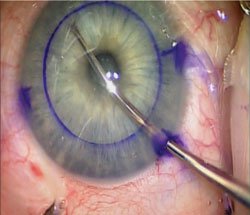 Figure 1. Case 1: An external circular 8-mm epithelial mark is made on the recipient cornea as a guide to assist in the descemetorrhexis. |
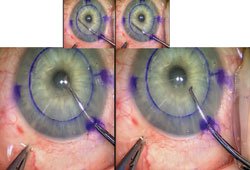 Figure 2. Case 1: John Dexatome spatula is used first to release the peripheral margins of the Descemet’s membrane in a circular manner (top row); this is then followed by removal of the Descemet’s membrane as a complete disc (bottom row). Images: John T
|
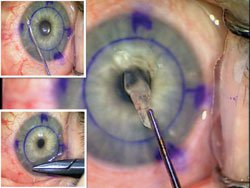 Figure 3. Case 1: The Descemet’s membrane is removed as a single disc (main figure); peripheral iridectomy is performed using John microscissors (upper insert); the temporal wound is closed with a 10-0 nylon suture (lower insert). |
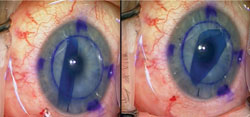 Figure 4. Case 1: One end of the Descemet’s membrane scroll is in the peripheral region of the anterior chamber (left); the Descemet’s membrane is moved to the central region of the anterior chamber (right). |
3. To prevent an acute glaucoma attack, make an inferior peripheral iridectomy. Figure 3 displays John micro-scissors (ASICO) being used to make the iridectomy. The temporal wound is closed with a 10-0 nylon suture (Figure 3).
4. During removal of the donor Descemet’s membrane, watch the periphery to ensure that the detachment and removal of the Descemet’s membrane follows the circular mark. Do not pull the Descemet’s membrane in haste because this can result in a Descemet’s membrane tear and potentially damage the donor corneal tissue with an added expense.
5. After introduction of the trypan blue-stained Descemet’s membrane into the recipient anterior chamber, close the entry wound with a single 10-0 nylon suture prior to any further manipulation of the donor tissue. Do not inject any fluid into the anterior chamber at this stage with an open temporal wound because this can potentially eject the donor Descemet’s membrane.
6. Do not work in the peripheral anterior chamber if possible (Figure 4). Move the Descemet’s membrane to the central region of the anterior chamber using fluidics and corneal manipulation. To avoid endothelial cell loss, do not directly touch the Descemet’s membrane. It is preferable to work in the central, deeper part of the anterior chamber for the unfolding and attachment of the donor Descemet’s membrane to the recipient cornea.
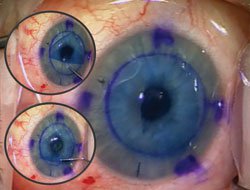 Figure 5. Case 1: The unfolding is usually performed using a no-touch technique (oval inserts). Descemet’s membrane is unfolded with the proper orientation: endothelial surface toward the anterior iris surface and well centered to the external circular mark (main figure). |
7. Use a no-touch technique to unfold the donor Descemet’s membrane within the recipient anterior chamber (Figure 5). Fluidics and external corneal manipulation usually help in the unfolding of Descemet’s membrane. Unfold the Descemet’s membrane with the proper orientation so the endothelial surface is toward the anterior iris surface and well centered to the external circular mark. This marks the end of the unfolding of Descemet’s membrane; no further manipulation is required at this time.
8. Do not try to mechanically move a decentered Descemet’s membrane with a reverse Sinskey hook as in DSAEK. Instead, detach the decentered Descemet’s membrane and move it to the center using a no-touch technique, and then reattach the Descemet’s membrane to the recipient cornea.
9. Ensure that the cannula tip is placed between the iris and the Descemet’s membrane and not over the Descemet’s membrane prior to air injection. Inject air in a controlled fashion to uniformly attach the Descemet’s membrane to the inner surface of the recipient cornea. A large air bubble is preferred in DMEK, while avoiding air extrusion into the retro-iris space.
10. At the end of the case, remove the loose, nonadherent epithelium with a Weck-Cel spear (Figure 6). However, during the surgery, if the visualization of the anterior chamber is poor, remove the epithelium to optimize intraoperative clarity.
11. Make sure that the donor Descemet’s membrane is uniformly attached to the patient’s cornea without any folds or irregularities and that a large air bubble is present (Figure 7).
 Figure 6. The loose, nonadherent epithelium is removed with a Weck-Cel spear (left film strip); proper centration of the donor Descemet’s membrane is visible (main figure). |
 Figure 7. Case 2: Proper centration of the Descemet’s membrane is ascertained prior to its attachment to the recipient cornea with a large air bubble to ensure a uniform attachment devoid of any Descemet’s membrane folds. |
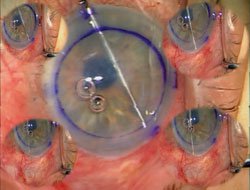 Figure 8. Case 3: Anterior synechialysis is performed prior to introduction of the donor Descemet’s membrane into the recipient anterior chamber. |
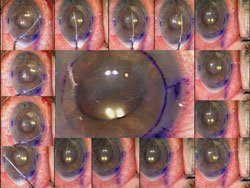 Figure 9. Case 4: Large fibrotic pupil with both anterior and posterior synechiae compromise the anterior chamber space and can potentially impede donor Descemet’s membrane introduction, unfolding and iatrogenic adherence of the membrane to the inner surface of the recipient cornea (central image); anterior and posterior synechialysis are performed before introducing the donor Descemet’s membrane (film strip). |
12. Do not introduce the donor Descemet’s membrane into the recipient anterior chamber if there are anterior synechiae (Figures 8 and 9). Perform anterior synechialysis prior to introduction of the donor Descemet’s membrane into the recipient anterior chamber in DMEK. Presence of anterior synechiae can impede unfolding of the donor Descemet’s membrane and also result in eccentric adherence to the recipient cornea.
13. Apply caution when dealing with a large fibrotic pupil. Donor Descemet’s membrane has a “magnetic tendency” to enter the pupil during fluidic unfolding of the Descemet’s membrane in an attempt to enter the posterior chamber and potentially disappear to undesired territory, such as the posterior chamber or segment. If this happens, retrieve the Descemet’s membrane back to the anterior chamber using gentle fluidics. Any mechanical manipulation will usually be detrimental to the donor endothelium, so such manipulations should be strictly limited. The John Pearl spatula (ASICO) and similar instruments may be helpful in such difficult cases.
14. Select as your first cases eyes that have near normal anterior chamber and corneal diameter. A very deep or very shallow anterior chamber with iris bulging forward may be considered a more difficult case, especially in the beginning phase of the learning curve for DMEK.
References:
- Dapena I, Ham L, Droutsas K, van Dijk K, Moutsouris K, Melles GR. Learning Curve in Descemet’s Membrane Endothelial Keratoplasty: First Series of 135 Consecutive Cases. Ophthalmology. 2011;118(11):2147-2154.
- Dirisamer M, Dapena I, Ham L, et al. Patterns of corneal endothelialization and corneal clearance after descemet membrane endothelial keratoplasty for fuchs endothelial dystrophy. Am J Ophthalmol. 2011;152(4):543-555.
- Guerra FP, Anshu A, Price MO, Price FW. Endothelial keratoplasty: fellow eyes comparison of Descemet stripping automated endothelial keratoplasty and Descemet membrane endothelial keratoplasty. Cornea. 2011;30(12):1382-1386.
- Jacobi C, Zhivov A, Korbmacher J, et al. Evidence of endothelial cell migration after descemet membrane endothelial keratoplasty. Am J Ophthalmol. 2011;152(4):537-542.
- Thomas John, MD, OSN Cornea/External Disease Board Member, is a clinical associate professor at Loyola University at Chicago and in private practice in Oak Brook, Tinley Park and Oak Lawn, Ill. He can be reached at 708-429-2223; fax: 708-429-2226; email: tjcornea@gmail.com.
- Disclosure: Dr. John receives a small royalty from ASICO.

